I participate in the Amazon affiliate program and may earn commissions from purchases made through links on this page.
Table of Contents
- Introduction
- Pros & Cons of TPO Roofing
- What Is TPO Roofing?
- TPO Roof Membrane Colors
- TPO Roofing Solar Reflectance
- Appropriate Uses for TPO Roofing
- How Long Do TPO Roofing Systems Last?
- Best TPO Roofing Manufacturers
- TPO Roof Repairs
- Popularity of TPO Roofing
- Timeline: Development and Growth of TPO Roofing
- TPO Roofing FAQs
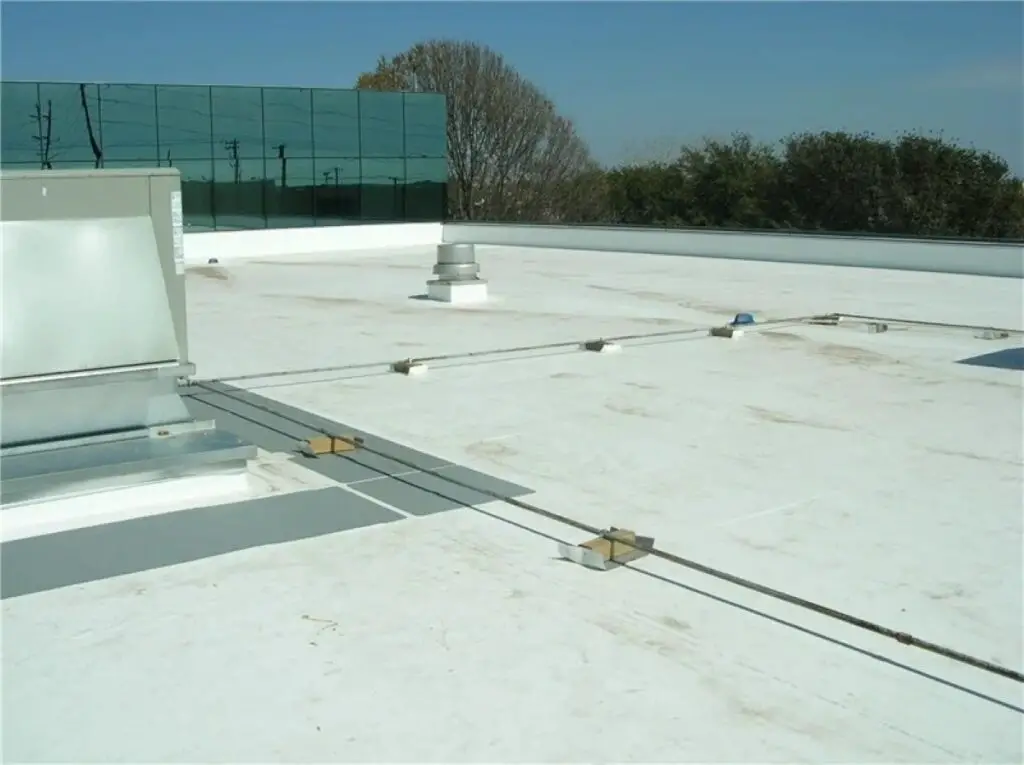
Introduction
TPO roofing has become very familiar to building owners and property managers – it’s that bright white roofing membrane constantly being recommended by roofing contractors. TPO is now the most popular single-ply roofing membrane in the United States when it comes to new low-slope roofing applications.
The first time a “TPO-type” roofing product was used in the U.S. was around 1987, and TPO roofing successfully entered the U.S. commercial roofing market in the 1990s. In the last 15 years, interest in TPO single-ply roofing has skyrocketed. The material’s popularity grew as manufacturers refined the polymer formulation and improved seam strength, puncture resistance, and UV stability, making current TPO systems much more durable than the earliest versions. I’ve noticed more and more clients asking about TPO when their old roofs are starting to fail and it’s time to discuss a roof replacement.
Unfortunately, it can be hard to find good information on TPO roofing. There is no reputable TPO Roofing Association the way there’s an EPDM Roofing Association. While organizations like ASTM International and FM Approvals have established performance standards for TPO membranes (such as ASTM D6878), there is still no central industry body that collects long-term performance data or publishes best-practice guides specifically for TPO.
Because TPO roofing systems have a relatively limited history of widespread use in the United States, there isn’t a large body of TPO roofing research, technical papers, practical guides, or other reliable reference resources in English like there is for more established materials such as asphalt, EPDM, or PVC. That said, several laboratories and research organizations have begun studying TPO’s long-term weathering characteristics, especially regarding heat aging and ultraviolet exposure.
But still, most of the TPO roofing information that you find on the internet was written by a roofing contractor who is trying to sell you a TPO roof.
I’m a roof consultant, not a contractor. I’ve been specifying, inspecting, and maintaining TPO roofing systems for over 20 years. I’ve overseen maintenance and leak repair programs for quite a few TPO roofs. I’ve also spent a lot of time as a quality assurance observer during TPO roof installations. (Quality assurance observation means that you stand on the roof during the installation and watch everything that goes on during the job. You make sure that the roofing contractor is installing the material according to best practices, the manufacturer’s recommendations, and the consultant’s specifications for that particular roof.)
I try to keep up-to-date on the latest developments in TPO roofing.
I know TPO roofing pretty well, and I thought I would share some helpful information about TPO roofing systems here on my website. My goal is to give property managers and building owners a clear understanding of how TPO roofs perform, what their advantages and limitations are, and how to decide whether this type of roof is the right choice for their building.
Pros & Cons of TPO Roofing
In case you’re just reading this article to get a quick sense of the advantages and disadvantages of a TPO roof, here’s a short run-through of the strong points and weak points of TPO roofing. I’ll be covering all of these items in more depth in the rest of the article.
Pros of TPO Roofing
Cool Roof
Standard thermoplastic polyolefin roof membranes come with a white, highly reflective surface for energy savings, LEED points, etc. Installing TPO single-ply membrane roofing is widely considered to be a cost-effective way to improve your building’s energy efficiency. Most white TPO membranes meet Cool Roof Rating Council (CRRC) requirements, with initial solar reflectance values typically above 0.70. High reflectivity can help reduce air-conditioning costs in warm climates.
Water Resistance
TPO roofing is more resistant to ponding water (standing water on the roof) than most other types of modern roofing membrane. It’s often used as a pond liner. (But extended ponding can still lead to accelerated aging, microbial growth, and membrane discoloration.)
Decent Grease Resistance
When compared to EPDM or asphalt-based roofs (such as built-up or modified bitumen), TPO roofing is far, far more resistant to the kitchen grease that can build up on a roof thanks to kitchen exhaust fans.
Even though TPO is a solid choice for a restaurant roof, PVC roofing is better, and a proper rooftop grease containment system is always strongly recommended for restaurant roofs. I’ve seen restaurant roofs where TPO membranes have degraded prematurely when there wasn’t a grease containment system.
Lower Material Cost
TPO is usually somewhat cheaper than other white single-ply systems of the same thickness and attachment style. Mechanically fastened 45-mil TPO is the cheapest reflective white commercial roof system there is.
The cost of TPO roofing is commonly considered one of the main benefits of the TPO single-ply membrane roofing system. It’s also widely available from nearly every major commercial roofing manufacturer, which helps keep pricing competitive and ensures that repair materials are easy to source.
Lower Installation Cost
It’s easy to get competitive bids for a TPO roofing installation. Every commercial roofer on the planet seems to specialize in TPO these days. This makes it easy to put together a bid list full of qualified roofers to get the best price you can. This also means that high-quality repair services should be easy to find.
(Recyclable Material)
You may see claims that TPO is made of recycled materials. This is sort of, technically, legalistically true. They often contain some pre-consumer recycled content. But while TPO membranes are themselves recyclable, this doesn’t mean that old TPO roofing material gets turned into new roof membranes. Old TPO can be recycled for use in other materials, though.
New high-quality TPO membranes will usually contain around 10% pre-consumer recycled material, and 0% post-consumer recycled content. This means that no old TPO roofing gets removed from a roof, recycled, and used to make new TPO membranes. A few manufacturers have recycling programs for production scrap, but large-scale closed-loop recycling of post-consumer TPO membranes has not yet become practical in the U.S. roofing industry.
Cons of TPO Roofing
Easily Punctured
When compared to the two other main types of single-ply membrane, TPO falls in the middle when it comes to puncture resistance. It is tougher than EPDM but not as tough as PVC.
But the important thing to remember is that TPO is still a single-ply material, which means that it is far more susceptible to punctures (and puncture-related leaks) than other low-slope roofing materials such as built-up roofing or modified bitumen membranes. Walk pads or pavers should always be installed in high-traffic areas.
Limited Track Record
TPO has a shorter track record than other roof systems. Best practices for TPO roofing are still being developed. Optimal formulations for TPO are still being worked out by roofing manufacturers. Early formulations from the 1990s and early 2000s were known to suffer from premature heat-aging failures, but modern versions (especially since about 2013) have shown greatly improved performance in accelerated weathering tests. Still, real-world long-term data beyond 25 years is limited.
Membrane Material Consistency
Material consistency during the production of TPO sheets is relatively hard to maintain. Among other issues, this can cause problems with heat-welding the membrane seams when different parts of the same sheet have different temperature windows. This was more of a problem in the early years of TPO than it is now. But you should still only use TPO materials from manufacturers with excellent reputations and production standards.
Shorter Lifespan
In my experience and the experience of other roof consultants I’ve talked to, thermoplastic polyolefin roofs have a shorter lifespan than other single-ply roof systems with the same membrane thickness and membrane attachment style.
Roof Cleaning
White TPO, like all white roof membranes, will need to be cleaned every two or three years to maintain the energy savings that a cool roof membrane provides. When it gets dirty, its reflectance score drops.
Stiff Membrane
TPO membranes are stiffer and don’t conform to angle changes as well as other single-ply membranes. This makes it harder to work with, which can result in more installation errors even when it’s installed by trained roofers if they lack experience with TPO. Detailing at corners, penetrations, and curbs is more difficult, and the seam quality in these areas often determines long-term roof performance.
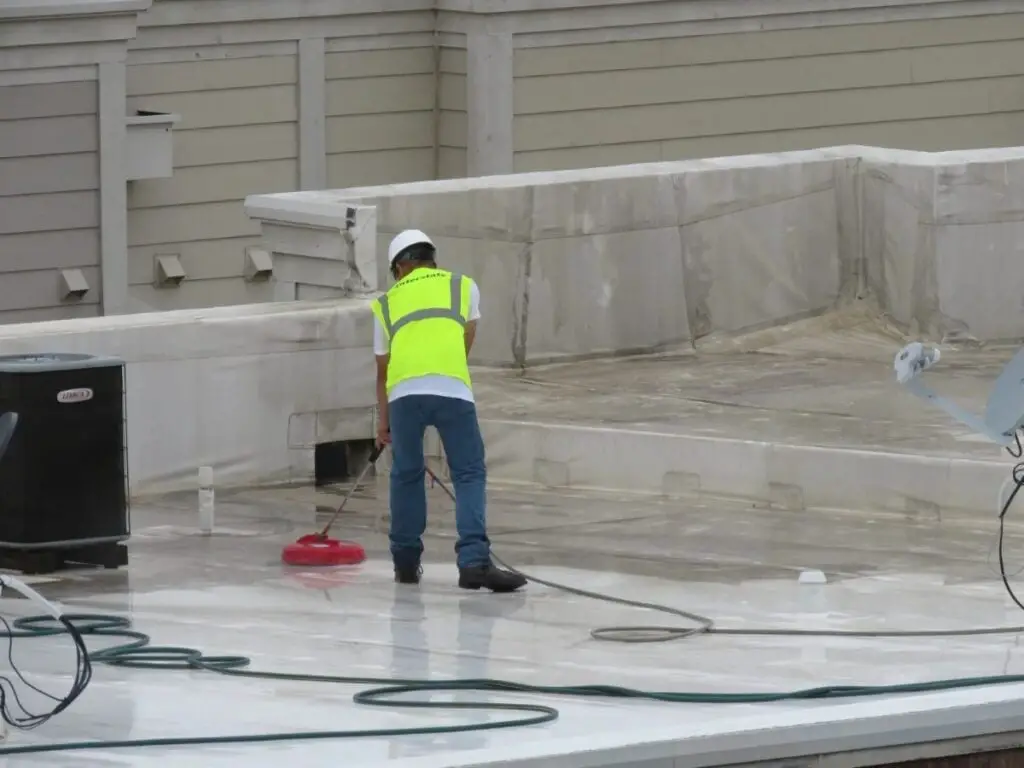
What Is TPO Roofing?
“Single-ply roofing is a roofing system in which the principal roof covering is a single layer flexible membrane, often of thermoset, thermoplastic, or polymer-modified bituminous compounds.” (from RCI’s Glossary of Roofing Terms)
TPO roofing is a type of single-ply roofing in which sheets of TPO membrane are used as the primary waterproofing material. TPO, which stands for “thermoplastic polyolefin,” is heat-weldable (that’s the thermoplastic part) and extremely UV-resistant.
TPO Roof Membrane
The TPO membrane is delivered from the factory in large rolls. The sheets are typically 10 feet wide and 100 feet long, although there are many other sizes available. Wider sheets (rolls up to 16 feet wide are currently available) can reduce the number of field seams, which helps lower labor time and potential leak points.
The standard thicknesses of TPO roof membranes are 45-mil, 60-mil, and 80-mil. (A “mil” is 1/1000 of an inch; it does not stand for “millimeter.”) The thicker the material is, the longer the roofing membrane normally lasts, and the longer the warranty coverage will normally be. Most commercial installations today use 60-mil or 80-mil membranes, while thinner 45-mil versions are typically reserved for smaller or lower-budget projects.
A sheet of TPO roof membrane has three layers: a TPO polymer base, a polyester reinforcement fabric middle layer (called the “scrim”), and a TPO polymer top ply. These three layers are heat-fused at the factory to produce the final product. The reinforcement scrim gives the membrane its tensile strength and dimensional stability, while the top ply contains UV stabilizers and weathering compounds to protect against UV degradation.
The main chemical component in a TPO roof membrane is propylene-ethylene copolymer. The finished TPO products also contain fire-retardant chemicals, colorant, ultraviolet radiation absorbers such as titanium dioxide, and possibly other proprietary additives. These formulations vary by manufacturer, which is why some brands perform better in long-term heat-aging and accelerated weathering tests than others.
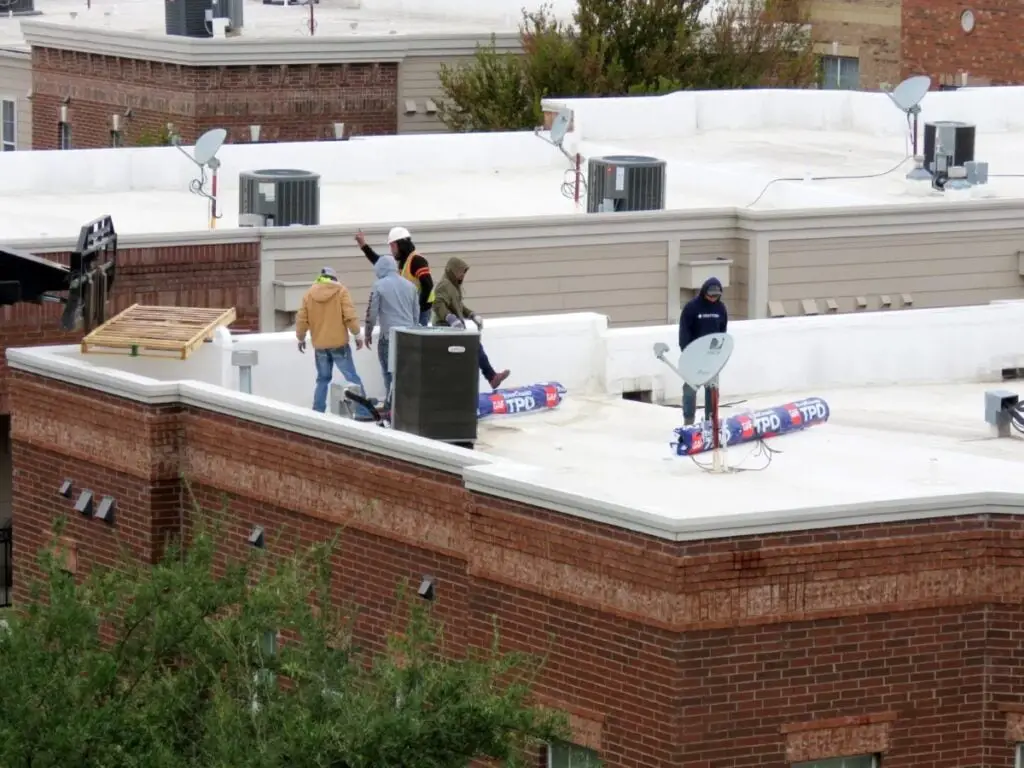
Heat-Welding TPO
Thermoplastic polyolefin roofs are installed the same way that PVC roofs are, using extremely hot air to join the TPO sheets together to create a continuous waterproof barrier that covers the entire surface of the roof. This process, known as “hot-air welding,” creates a homogeneous bond between sheets that is both watertight and chemically fused.
TPO membranes are thermoplastic, unlike EPDM roofing, for example, which is thermoset. Thermoplastic means that you use heat to create the original membrane seams and you can always use heat (hot air typically at 1004° Fahrenheit) to weld patches onto or otherwise modify a TPO membrane for the life of the roof. Thermoset means you can’t. You have to use adhesives to make the seams.
This heat is applied using either a hand-held hot air welding gun or a self-propelled automatic hot air welding machine (called a “robot” by TPO roof installers). The robot is used for the long seams in the field of the roof, while the heat gun is used for flashings and patches. During installation, the correct temperature and travel speed of the robot are verified using test seams, which are then physically pulled apart to confirm proper bonding strength.
Heat welding is the proper way to seam TPO sheets together, to install TPO roof flashings, and to apply patches to the roof if it needs to be repaired. It’s also the approved method for attaching membrane accessories such as pipe boots, walkway pads, and pre-molded corners. The heat-welded seams in a TPO roof system are exceptionally strong, actually stronger than the rest of the TPO sheet. A properly made seam can exceed the membrane’s own tensile strength.
Having heat-welded seams means that adhesives are not used to join the roof membrane sheets together, so adhesive failure and seam delamination are not problems for TPO roofs. This reduces long-term maintenance issues that are common with glued or taped systems.
Unlike PVC, which is TPO’s main competitor as a white, cool roof membrane, the TPO roof membrane material does not rely on plasticizers to maintain flexibility over the life of the roof. This means that the membrane does not lose flexibility over time because of plasticizer loss. TPO can still become somewhat stiffer with age due to oxidation and exposure to heat.
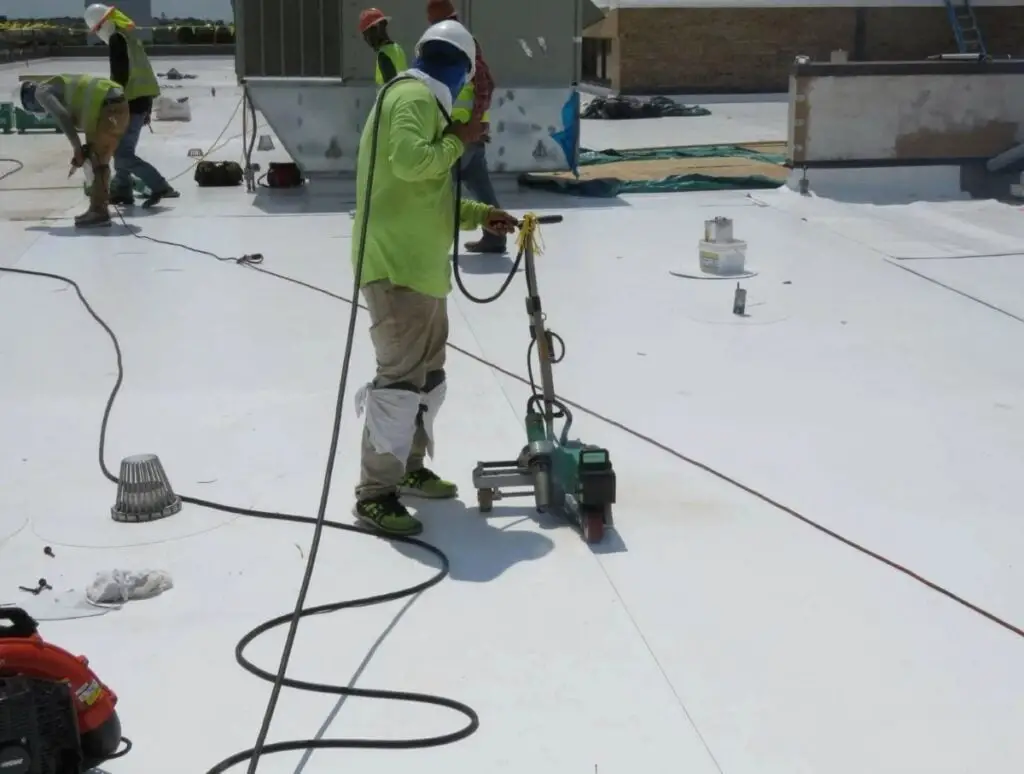
Typical TPO Roof Assembly
A typical TPO roof assembly consists of (1) the roof deck, usually concrete or corrugated steel; (2) a layer of insulation (typically polyisocyanurate board) that varies in thickness according to local R-value requirements – these days 4 to 6 inches is common; (3) a cover board (most commonly 1/2-inch or 5/8-inch gypsum board); and (4) the TPO membrane itself.
A vapor barrier installed over the roof deck may be required in many areas, depending on the local climate. Cold climates, or buildings with high interior humidity such as swimming pools and food processing facilities, almost always require one.
The typical installed thickness of a new TPO roof system (excluding the roof deck) will usually be around 6 inches, but this will vary according to the insulation type and local R-value requirements. U.S. energy codes generally call for total roof insulation R-values between R-20 and R-35 for commercial buildings, depending on climate zone; this determines how much insulation is needed.
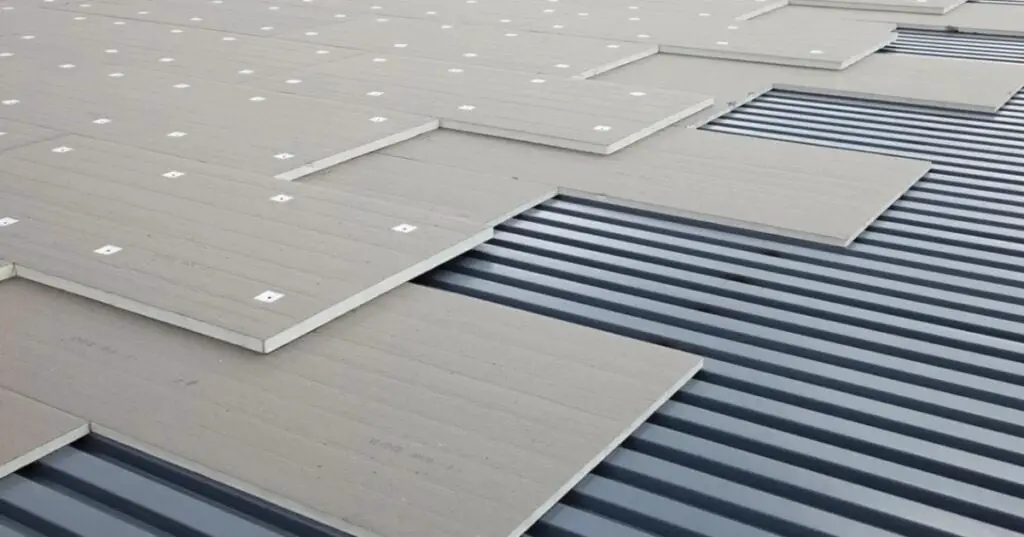
A typical TPO roof system weighs a little over 3 pounds per square foot (excluding the roof deck). This light weight makes it suitable for retrofit projects where structural load limits are a concern. Almost all TPO membranes are either fully-adhered, which means that the entire membrane is glued to the cover board, or mechanically-attached, which most often means that the TPO roofing sheets are individually fastened down into the roof deck using a line of fasteners hidden inside the heat-welded seams that join the sheets together.
Fully adhered systems generally provide a smoother appearance and better wind-uplift resistance, while mechanically attached systems are faster and less expensive to install. Wind-uplift ratings should always be verified for each roof assembly, especially in high wind regions.
TPO roofing can also be ballasted; this is an attachment system in which the layers of the roof system are loose-laid, without fasteners or adhesives, and depend on ballast weight to hold the roof in place. The ballast normally consists of river-washed stones or concrete pavers installed across the entire surface of the roof at an installed weight of 10 to 20 pounds per square foot. Ballasted TPO roof systems are rare because the ballast covers up the roof membrane, cancelling the reflective value of a white TPO roof.
This short video from Carlisle SynTec Systems will give you a good idea of how a mechanically-attached TPO roof system is put together, although it’s very basic and doesn’t include the cover board that usually goes over the insulation:
TPO Roof Membrane Colors
All TPO roofing membranes have a gray bottom ply, which you can’t see once it’s installed. A huge majority of thermoplastic polyolefin roofs are white, that is, they have a white top ply, since a huge reason for using TPO is that it can provide a reflective cool roof membrane, and white membranes are the most reflective. A white TPO roof can reflect up to 80 percent of solar radiation when new, helping reduce cooling loads and heat-island effects in urban areas.
TPO roofing actually comes standard from most manufacturers in more than just white. You can get TPO in white, tan, and gray from almost all manufacturers without it being a special order. These standard colors are often stocked by distributors and qualify for the same UL and FM ratings as white membranes, though reflectivity values vary; tan and light gray typically reflect between 60 and 70 percent of sunlight.
Many other custom colors are available as well, but you normally have to order enough of the material to make it worth the manufacturer’s while.
GAF TPO roofing, for instance, can be manufactured in 15 pre-formulated TPO colors, including green and red, but you need to order at least 40,000 square feet worth of membrane in order for them to make it for you. Other major manufacturers such as Carlisle, Holcim Elevate, and Johns Manville also offer custom-color programs, typically requiring similar minimum order quantities and lead times of six to eight weeks. Custom colors may not achieve the same solar-reflectance index (SRI) as white membranes, so they are rarely used where “cool roof” compliance is required.
White TPO is the practical choice for most low-slope commercial buildings, while gray or tan membranes are sometimes selected to better match building color schemes or to reduce glare from high-visibility roof areas.
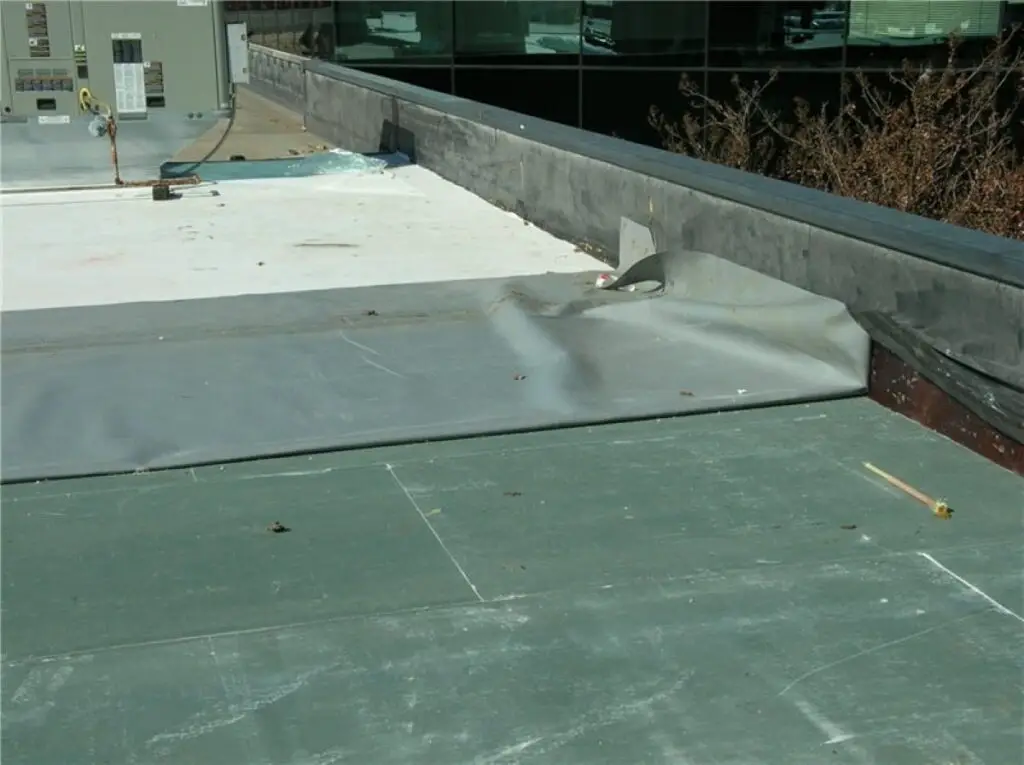
TPO Roofing Solar Reflectance
One assumption that a lot of people have about colored TPO is that if the roof membrane isn’t white, it won’t be as “cool” and it won’t qualify for LEED points.
This is only partially true. The solar reflectance of tan TPO roofing, for instance, isn’t much lower than that of the white TPO. Colored TPO membranes can meet energy savings requirements and qualify for LEED points. Many building owners don’t realize that light-colored tan and gray membranes often exceed local “cool roof” code requirements, even if they don’t reach the maximum white-membrane values.
To earn LEED credits, a low-sloped roof surface needs a minimum initial SRI of 82 or a minimum three-year aged SRI of 64. You can read more about LEED roof credits on the Buildings website. LEED uses the Solar Reflectance Index (SRI), which combines both solar reflectance and thermal emittance to rate materials.
The initial solar reflectance (Solar Reflectance Index – ASTM E1980) for white TPO is 99. The initial solar reflectance is 86 for tan TPO. (And it’s 53 for gray TPO.)
The 3-year aged Solar Reflectance Index for white TPO is 85, while for tan TPO it’s 77. (And 48 for gray TPO.)
These values can vary by manufacturer and specific product. Product data sheets are typically available on the roofing manufacturer’s website where you can find the solar reflectance information for any roof membrane (normally under “Radiative Properties”).
Appropriate Uses for TPO Roofing
TPO can be installed on just about any building with a low-slope (“flat”) roof. Buildings with flat roofs are designed for low-slope roofing systems like TPO. A low-slope roof is a roof with a slope that is less than 3-in-12 (< 14.04°).
TPO roofing is not appropriate for steep roofs. Buildings with steep roofs are typically designed for steep roofing systems like shingles or tiles. A steep roof is considered to be any roof with a slope that is 3-in-12 or more (≥ 14.04°).
The minimum allowable roof slope for a TPO roof is ¼-in-12 (1.19°), as prescribed by the International Building Code. No maximum slope is specified. When slopes exceed about 3-in-12, sheet slippage and aesthetics become practical limitations, and special installation details are needed. Proper ventilation also becomes a vital consideration when single-ply membranes are used on roofs that were designed for shingled materials, as the membrane will also function as a vapor barrier.
If a low-slope cool roof is appropriate for your building, then TPO roofing is an appropriate choice. Whether a cool roof is always appropriate for every building in every climate is another matter altogether, and there’s an ongoing debate around the subject. But that would be the subject of an entirely different article.
Commercial TPO Roofing
TPO is a huge part of the commercial roofing industry. Thermoplastic polyolefin roofs are installed on office buildings, apartment buildings, hotels, factories, warehouses, shopping malls, big box stores, hospitals, schools, and other government buildings.
Almost every commercial roofing company in the country will have experience with TPO roofing and offer TPO roofing installation as one of their services. Because of that, competition is strong, but so is the variation in workmanship quality.
Get Competitive Bids
There’s a lot of money in commercial TPO roofing, and too much of it might be coming out of your pocket. To avoid paying way too much for your TPO roof, you need to get competitive bids from 4 or 5 different roofing contractors that are all based on the same precise, professional TPO roof specification.
If you don’t want to hire a roof consultant to produce a spec, the best TPO roofing manufacturers can often provide you with a decent roof specification for free. The spec will be generic (not customized for your roof) but it will be better than nothing.
There will be contact information for the TPO roofing manufacturer’s technical department on the manufacturer’s website. Call them and ask about a specification. They will probably be able to recommend a few of the best TPO roof installers in your area, as well.
If you let a roofing salesman talk you into awarding his company a roof installation contract without a competitive bidding process, you will end up overpaying for your new roof, possibly by as much as 30%.
As a roof consultant, I know a lot of roofing contractor salesmen and estimators, and I know the cost of labor and material. So I know what a new roof should cost.
I was surprised during a recent conversation with a salesman for a top-five national roofing contractor. The salesman claimed that his company’s top competitor routinely turned a profit of around 40% on most of the roofs they installed. He said his own company only averaged around 25% (and less than that when they successfully bid on one of my jobs).
We never invited this other company to bid on the projects we handled, so I had no idea they were charging so much and getting away with it. From what I gathered, they rarely bid on jobs when there’s a roof consultant involved, because they can make a lot more money from less savvy customers. Their sales team is simply that good. (Unfortunately, their roofers aren’t; I’ve inspected their work.)
Which brings us to:
Use a Roof Consultant
I strongly recommend that you hire a professional roof consultant if you’re planning to have a large commercial TPO roof installed. A roof consultant can make sure you don’t get taken advantage of in an industry not particularly known for its ethics.
While a roof consultant will typically charge about 5%–10% of the total cost of the project, they can often reduce what you would otherwise end up paying for the roof by writing a precise roof specification, conducting a competitive bid process, monitoring the work, and enforcing the contract documents.
The independent quality assurance inspections a roof consultant can provide often save a ton of headaches down the road.
The value of a roof consultant’s involvement for long-term roof performance and roof life expectancy is well-understood in the industry. It’s why insurance companies often require the involvement of an accredited roof consultant in order for the building owner to get the best rates on their insurance.
Residential TPO Roofing
TPO roofing is not normally considered residential roofing, although it’s a perfectly fine choice for apartment buildings, condominiums, and other residential buildings with flat roofs. It’s not good for most houses.
A lot of people want to know if they can install TPO roofing on their house. The short answer is no, not if your house was designed for a steep roof material. And you probably wouldn’t want to put it on your house anyway because of the way it would look.
First of all, you have to take into account how dirty a white TPO roof membrane will get after just a year or two. Everyone can actually see a pitched roof – it’s not hidden out of sight like a flat roof. A new gleaming white TPO roof would take less than a year or two to become an unattractive, splotchy, gray, dirt-streaked roof. You’d have to wash it every year to keep it presentable.
Second of all, TPO is a flat (low-slope) roofing material. Flat roofs and steep roofs, and the buildings underneath each one, are designed differently. A TPO membrane doesn’t just form a watertight membrane; it also forms an airtight (and water-vapor-tight) membrane as well. If you put a TPO roof on your pitched roof, you’ll probably end up trapping debilitating amounts of heat and moisture underneath the roof.
Both the heat and the moisture can cause big problems. Dry rot, mold, and warped sheathing can result. Because a shingled roof does not form a continuous barrier, it allows the heat and moisture to pass harmlessly up and out through the roof.
The various building systems in buildings with low-slope roofs are engineered to account for this issue.
That being said, if your house has a flat roof on it, then yes, you can install TPO roofing on your house. In fact, TPO is one of the most common materials used for residential flat-roof additions such as carports and sunrooms because it’s durable, lightweight, and relatively affordable.
TPO roofing can also be used for some other roofs on residential properties. Even pitched roofs on unheated buildings such as sheds or barns are suitable. Flat roof sections over porches, garages, and even some dormers will have been designed for a low-slope material. In those cases, TPO can be an excellent idea. Just remember the warning about TPO showing the dirt.
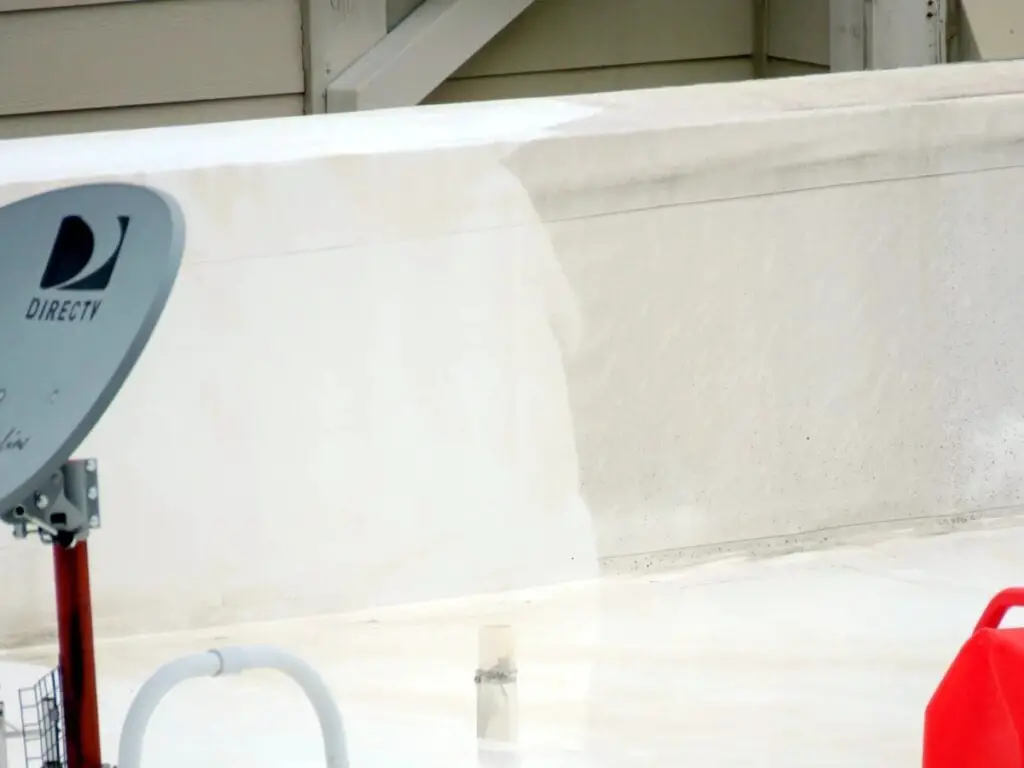
How Long Do TPO Roofing Systems Last?
A TPO roofing system can last anywhere from 15 to 40 years, depending on a number of variables.
As with all roof systems, the life expectancy of a TPO roofing system depends on how well the roof was installed (workmanship), the thickness and quality of the materials, the roof’s maintenance history, and the local climate. Very hot environments with high UV exposure can shorten TPO service life significantly (PVC performs better under these conditions). Poor roof drainage can also reduce lifespan, while regular inspections and maintenance can extend it.
Another lifespan factor with TPO is the roof system attachment method. Fully adhered systems generally last longer than mechanically attached systems.
Thicker roof membranes typically last longer than thinner roof membranes; this is reflected by the length of the manufacturer warranties available for each thickness level. You’ll never find a warranty for 45-mil TPO that has a longer coverage period than a warranty for 80-mil TPO.
Manufacturer warranty periods (from reputable manufacturers!) are also a good predictor of roof life expectancy. After all, manufacturers know their product, and they have a serious interest in ending warranty coverage before a roofing material reaches the end of its service life.
They also have an interest in offering the longest warranty period they can, because that helps sell roofs. They have to strike a balance: a warranty that is as long as possible without ending up costing them money due to having to cover normal end-of-life roof failure.
So the warranty periods offered by respectable TPO roofing manufacturers tend to stop about 5–10 years before the average TPO roof will fail due to normal, predictable material aging. Typical manufacturer warranties today range from 15 years for basic 45-mil membranes to 30 years for premium 80-mil fully adhered systems installed by certified contractors.
TPO Roof Lifespan by System Type
These are the commonly accepted typical lifespans for properly installed TPO roofing systems:
- 45-mil mechanically attached TPO roofing systems are typically expected to last around 20 years.
- 45-mil fully adhered TPO roofing systems are typically expected to last around 25 years.
- 60-mil mechanically attached TPO roofing systems are typically expected to last around 25 years.
- 60-mil fully adhered TPO roofing systems are typically expected to last around 30 years.
- 80-mil mechanically attached TPO roofing systems are typically expected to last around 30 years.
- 80-mil fully adhered TPO roof systems are typically expected to last around 35 years.
In mild climates with limited temperature swings, these lifespans will usually be above average, while in hot southern or desert climates, the same systems may have a below average useful service life.
To compare the lifespans of TPO roof systems to other types of roofing, please see my article on general roof life expectancy.
Best TPO Roofing Manufacturers
Part of my job as a roof consultant is to specify the type of roofing material to be used in a roofing project and to list the acceptable manufacturers whose products can be used for the job. I’ve been dealing with commercial roofing manufacturers for decades (some of them aren’t in business anymore). Through my own experience and networking in the roofing industry, I’ve developed a short list of manufacturers who make top quality TPO roofing.
These manufacturers have a reputation for high manufacturing standards, honoring their warranties without a lot of baseless arguments, and being honest about what their products can and cannot do. Their products consistently perform well in independent laboratory tests.
There was a study performed in 2015 to test and rank the quality of TPO roofing products from the top TPO roofing manufacturers. The study was commissioned by GAF, although it was performed by an independent testing laboratory. The full report is no longer available online, apparently. A summary can still be found on the website of Dezigns Construction (DCI).)
It might be a coincidence that the manufacturers in the study are the same ones on my list (I had my list before I read the study).
Remember that new TPO roofing formulations are still being tested by manufacturers. The TPO that a manufacturer was producing 10 years ago may not be the same product that they’re making today. And just because I don’t list a manufacturer here doesn’t mean they don’t make high-quality TPO. (Here’s a full list of TPO roofing manufacturers.)
Here’s my list of the best TPO roofing manufacturers:
- Carlisle SynTec Systems
- Firestone Building Products (now Holcim Elevate)
- Johns Manville
- GAF
These companies have the broadest warranty programs, the most field data, and strong technical support. Most also manufacture their own insulation and cover board components, allowing complete system warranties when all materials come from one brand.
TPO Roof Repairs
If you aren’t a roofer who works with TPO, TPO roofing is one of the most difficult roofing materials to repair properly in accordance with the manufacturer’s instructions. This is because of the heat-welding. Applying a proper TPO roof patch requires specialized TPO roofing tools (the heat welder in conjunction with the hand roller) and experience using them.
If your TPO roof is still under warranty, any repairs should be made by a roofing contractor approved by the manufacturer. Improperly made or unapproved repairs may be enough to void the warranty in some situations. You don’t want to give the manufacturer any reason to deny a future warranty claim. This goes for repairing items not even covered by the warranty, such as roof membrane punctures made by careless HVAC mechanics, for example. You still want a manufacturer-approved contractor to repair the roof.
If you have a preferred roofer who you want to use, you should call the manufacturer’s warranty department and check if it’s OK (it usually is). If you don’t have a roofer in mind, the manufacturer will give you the contact information of approved TPO roofers in your area.
If your roof warranty has expired, it’s a different ballgame. TPO roofing is among the easiest roofing materials to repair if you don’t need to do it as directed by the manufacturer for warranty reasons.
Although it’s still a good idea to have proper repairs made by a roofing contractor who has experience with TPO roofing systems, you can actually make most simple repairs yourself. You don’t need to use a heat welder, or even TPO. Roof punctures, tears, or open roof seams can be fixed using third-party roof repair tape. TPO is probably the most compatible single-ply roofing material there is when it comes to roof repair tape. Many roof sealant tapes use TPO as the protective backing on the tape due to its compatibility with the adhesive part of the tape.
A roof patch made with a good repair tape can last more than 20 years under the right conditions, and if your roof is already out of warranty, this probably means it will probably last for the rest of the life of the roof.
If you want to repair your TPO roof yourself with repair tape, you’ll need to thoroughly clean the area with warm, soapy water and follow the instructions from the tape manufacturer. I explain how to use roof repair tape (and list the good ones) here on this page.
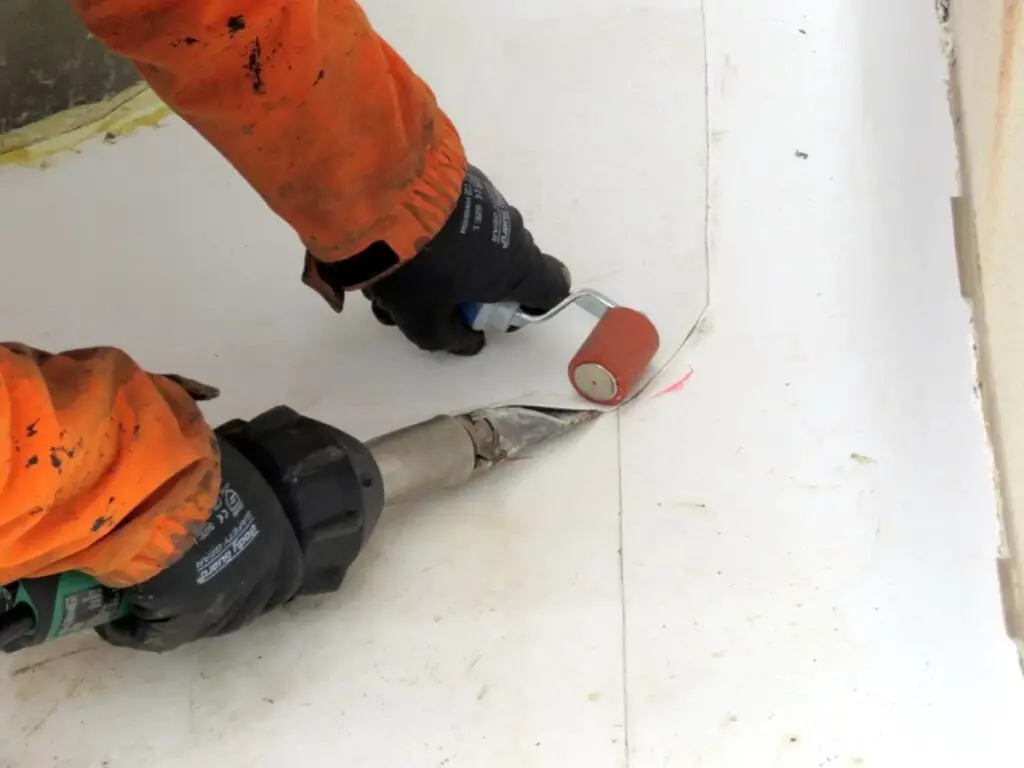
Popularity of TPO Roofing
TPO roofing is the single most popular type of roofing for new installations on flat (low-slope) roofs in the United States today. 40% of all new single-ply roof installations in 2019 used a TPO roof membrane, with that market share projected to increase. This means that right now, out of all new flat roofs in general, more than 3 out of every 10 are made out of TPO (single-ply isn’t the only option).
In the year 2000, almost nobody knew what TPO roofing was. The use of TPO as a roofing material has truly skyrocketed over the past 20 years. So why is TPO roofing so popular now?
The popularity of TPO roofing has been driven mainly by a huge increase in demand for white (cool) single-ply roofing in the last 20 years. This demand is due in part to the savings on energy that a white roof membrane can provide by reducing building cooling expenses. Federal and state energy codes, combined with programs like LEED and ENERGY STAR®, also encouraged the widespread adoption of reflective roof membranes for both commercial and institutional buildings.
Stricter energy code requirements and the rise of LEED have made the use of white roof membranes practically mandatory in many places. But why TPO instead of one of the other white roofing materials?
In the early 2000s, I knew about TPO roofing as an alternative to white PVC and white EPDM for energy-saving cool roof installations. I also knew all about several serious issues with TPO roofing that had been identified both by researchers and by reports of real-life TPO roof failures. Those early TPO membranes were often too rigid, heat-aged poorly, and suffered from seam cracking under prolonged UV exposure. ASTM and manufacturers have since revised formulation standards several times to fix those problems.
The consultants at my company were not satisfied by the reliability of TPO, and we continued to specify PVC in place of TPO when we wanted a white membrane.
Around 2010, I started to notice something curious. Whenever a client needed a roof replaced and we put the project out to bid, the contractors started to pester me about maybe switching to a TPO membrane instead of whatever we had specified. Eventually, I asked a few roofing manufacturer sales reps what was going on.
Apparently, there was a huge push among U.S. roofing manufacturers to boost the volume of TPO roofing installations. The manufacturers wanted to make TPO a major part of their business because it was cheaper and easier to produce. Unlike PVC, TPO contains no chlorine and fewer proprietary ingredients, so material costs were lower and regulatory restrictions minimal. They were offering commercial roofing contractors greatly reduced prices on TPO material, which in turn led the roofing contractors to start pushing TPO every chance they got. TPO suddenly meant significantly more profit per roof for the contractors, even while they charged less for a roofing job.
As the contractors installed more and more TPO roofs, they effectively trained their crews to be TPO roof installers, which made them even more likely to recommend TPO to their customers.
The lower material price of TPO also made purchasing a new roof more attractive. More customers were willing to pay for a roof replacement instead of trying to keep their old roof going as long as possible. TPO roofing sales did, in fact, increase, and in a big way. So that’s how TPO burst onto the scene.
A TPO roof is still usually a bit less expensive than its competitors in the cool roof membrane market. It currently beats the other two types of single-ply roof membrane commonly used today, white EPDM and PVC membrane, on price.
In addition, many of our early concerns about TPO have been addressed by the TPO manufacturers. TPO roofing today is a much more reliable roofing material than it was in 2005 or 2010.
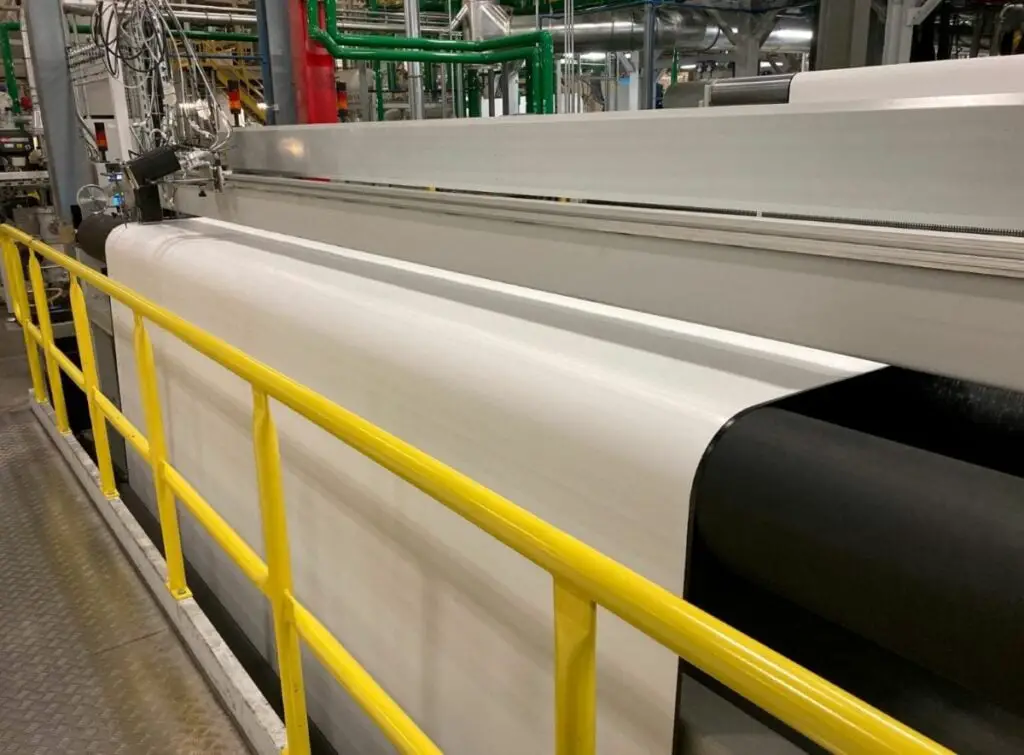
Timeline: Development and Growth of TPO Roofing
| Year / Period | Milestone or Development |
|---|---|
| Late 1980s | Thermoplastic polyolefin (TPO) membranes are first introduced to the U.S. commercial roofing market, adapted from earlier European flexible polyolefin (FPO) materials. The earliest roofing-grade formulations appear around 1989. |
| Early 1990s | TPO begins limited U.S. use as manufacturers experiment with a new single-ply alternative to PVC and EPDM. Early versions show promise for weldability and reflectivity, but premature heat-aging failures emerge in field installations. |
| Mid to Late 1990s | Major manufacturers including Carlisle, Firestone, and Johns Manville release branded TPO products. The industry begins recognizing the need for improved formulation stability and formal material standards. |
| 2003 | ASTM D6878, Standard Specification for Thermoplastic Polyolefin-Based Sheet Roofing, is first published, establishing material performance and testing requirements for thickness, aging, and seam strength. |
| Early 2000s | TPO adoption accelerates with the rise of cool roof energy codes and LEED® standards that encourage reflective white membranes for energy efficiency. However, formulation inconsistencies and roof failures lead to multiple rounds of manufacturer reformulations. |
| 2005–2010 | Second- and third-generation TPO membranes are introduced with improved UV resistance, weldability, and heat-aging performance. These refinements resolve most early reliability problems and make TPO a practical alternative to PVC. |
| 2010–2015 | Independent testing, including the 2015 GAF-commissioned comparative study, evaluates the heat-aging durability of TPO membranes from major manufacturers. Results show substantial differences among brands but confirm that newer formulations meet or exceed ASTM standards. |
| 2013–2017 | ASTM D6878 is updated (editions D6878-13 and D6878-17) to include tighter performance thresholds for thickness over scrim, seam strength, and accelerated weathering. These updates reflect lessons learned from the first two decades of TPO field performance. |
| Mid-2010s | TPO surpasses PVC and EPDM in market share for new low-slope roofs, reaching roughly 40% of the U.S. single-ply segment, according to NRCA-referenced manufacturer data and third-party reports. |
| 2020 | Field-aged TPO evaluations published by IIBEC and manufacturer studies show that well-installed systems maintain tensile strength, reflectivity, and flexibility after 15–20 years of service, validating long-term performance expectations. |
| 2020s | Modern fourth-generation TPO membranes demonstrate excellent durability in both laboratory and field testing, with some manufacturers reporting accelerated weathering results exceeding 16,000 hours under ASTM G155 exposure. Premium 80-mil systems are now offered with warranties of up to 25–30 years, and TPO continues to lead the U.S. low-slope roofing market. |
TPO Roofing FAQs
What is TPO roofing?
TPO stands for thermoplastic polyolefin, a type of single-ply roofing membrane made from a blend of polypropylene and ethylene-propylene rubber. TPO roofing is a popular option for flat and low-slope roofs. It’s known for its white reflective surface, heat-welded seams, and strong resistance to ultraviolet (UV) radiation, making it one of the most widely used commercial roofing systems in North America.
Which roof is better, EPDM or TPO?
Both EPDM and TPO are durable and reliable roofing options, but the best choice depends on the specific needs of your building. EPDM is more flexible, almost always black, and performs better in colder climates, while TPO is typically white, better for warmer climates, and more resistant to punctures and tears. TPO also offers heat-welded seams rather than taped seams, which usually means fewer long-term maintenance issues. EPDM, on the other hand, can outperform TPO in cold-weather flexibility.
Is TPO roofing expensive?
TPO roofing is generally less expensive than other flat roofing materials like PVC or modified bitumen. The cost of TPO roofing varies depending on the size of the roof, installation method, material thickness, and a few other factors. See this TPO roof cost guide for current estimated prices.
What is the average life of a TPO roof?
The average life of a TPO roof is 20–30 years, but thicker membranes with proper maintenance can last even longer. A well-installed 80-mil fully-adhered TPO roof can last up to 35 years, while mechanically-attached systems or thinner membranes tend to age faster, especially in harsh climates.
Can you walk on TPO roofing?
Yes, you can walk on TPO roofing, but it is important to take precautions to avoid damaging the membrane. Use soft-soled shoes and avoid walking on the roof in extreme temperatures or when the roof is wet or icy. For roofs areas with frequent foot traffic, such as those accessed to service HVAC equipment, it’s best to install walk pads or pavers to protect the membrane.
Why does a TPO roof leak?
TPO (thermoplastic polyolefin) roofs can leak for a variety of reasons, including improper installation, damage from foot traffic or wind-blown debris, and age-related wear and tear. Regular maintenance and inspections can help prevent leaks. Most leaks occur at seams, flashing transitions, or rooftop penetrations, areas where poor welding or inadequate detailing can compromise watertightness.
Is TPO roofing glued down?
TPO roofing systems can be installed using a variety of methods, including mechanically-attached, fully-adhered, and ballasted. Fully-adhered TPO roofing systems are glued down using a special membrane bonding adhesive. Mechanically-attached systems use rows of fasteners concealed under the seams, while ballasted systems rely on heavy stone or paver weight to secure the membrane.
Does TPO roofing need underlayment?
TPO roofs do not require a separate underlayment, but a slip sheet or separation layer may be used on top of the roof to protect the membrane from damage due to rooftop equipment or exposure to chemicals, oils, or grease. A vapor barrier may be installed over the roof deck in some TPO systems. In reroof applications, a separation sheet may also be used when installing TPO over an existing roof system to mitigate chemical incompatibility.
What do you put under TPO roofing?
Depending on the specific installation method, TPO roofing systems will almost always require insulation, and may require a vapor barrier. A cover board is often needed over the insulation to provide a smooth, hard surface for the membrane to adhere to. Common insulation types include polyisocyanurate (ISO), expanded polystyrene (EPS), and extruded polystyrene (XPS). The cover board, often gypsum, also improves hail resistance and fire performance.
Can a TPO roof be coated?
Yes, a TPO roof can be coated, but only under certain conditions. Coating is generally used to extend the service life of an aging membrane or to restore reflectivity once the surface has dulled. The roof must first be thoroughly cleaned, and the coating manufacturer must specifically approve its use over TPO. Most silicone, acrylic, or polyurethane roof coatings require a primer to ensure proper adhesion. Coating a TPO roof that is still under warranty may void that warranty, so it’s best to check with the roofing manufacturer before proceeding.
How do you maintain a TPO roof?
TPO roofing requires relatively little maintenance, but regular inspection is important. I recommend inspecting the roof twice a year, typically in spring and fall, and after major storms. Remove debris, check seams, drains, flashings, and rooftop equipment curbs, and repair any punctures or loose welds promptly. Cleaning the surface every two or three years with a mild detergent will restore reflectivity and prevent buildup of dirt or algae that can reduce energy savings. Proactive maintenance helps catch small issues before they cause leaks or shorten the roof’s lifespan.
Can a TPO roof be repaired in cold weather?
Yes, but it’s more difficult. TPO membranes become stiffer in cold temperatures, which can make heat-welding seams and patches tricky. Professional installers typically use higher welder settings and pre-warm the surfaces to achieve a proper bond. For temporary winter repairs, a high-quality TPO-compatible tape or sealant patch can be used until a permanent welded repair is made in warmer weather.

